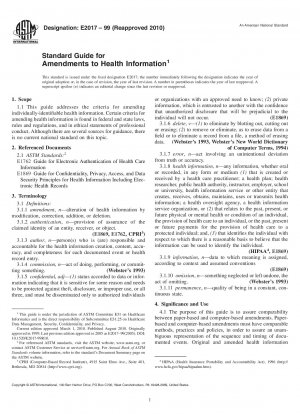ASTM E2017-99(2010)
Standard Guide for Amendments to Health Information
- Standard No.
- ASTM E2017-99(2010)
- Release Date
- 1999
- Published By
- American Society for Testing and Materials (ASTM)
- Status
- 2017-01
- Latest
- ASTM E2017-99(2010)
- Scope
The purpose of this guide is to assure comparability between paper-based and computer-based amendments. Paper-based and computer-based amendments must have comparable methods, practices and policies, in order to assure an unambiguous representation of the sequence and timing of documented events. Original and amended health information entries and documents must both be displayed and must be consistent across both domains. Comparability does not rule out, however, the use of capabilities specific to the electronic world, which do not have paper-based counterparts, for example, displaying the amended text with a pop-up window, which can show the text prior to its amendment.
Traditional paper-based health records and policies support the need of authorized authors of health information to amend entries and documents in the health record under appropriate circumstances. In a paper-based health record, amending entries is accomplished by drawing a line through the erroneous entry, writing in the correct information, and authenticating the amendment by signing and dating the change. Such corrections always display the original documentation along with the amendment. This procedure is used to assure an unambiguous representation of the sequence and timing of documented events and any appropriate amendments.
Current and emerging technologies for health records, including, but not limited to, computer-based health records, employ different input and display methodologies than the traditional paper-based record and, therefore, different amendment alternatives for health record or health information entries, or both. Health information may be entered directly into an automated, electronic, or computer-based health record system, for example, by voice, keyboard (either by the care practitioner, transcriptionist, or other intermediary), mouse, pen, tablet, a personal digital assistant, or through the use of structured data entry. Unlike a written record, which essentially is always viewed in its original handwritten or typewritten form, the presentation and display of electronic and computer-based health information often is transformed. This transformation occurs when information is transferred from one computerized system to another system or filtered by different display characteristics or views of the data. In addition, in contrast to the paper-based record, computers and computer systems can modify display of the data directly, for example, in nonchronological order or filtering through queries. Amended electronic records should display a distinct and obvious notation of their amended state. Access to the original health information should be immediately available, that is, prior amendments back to and including the original record.
1.1 This guide addresses the criteria for amending individually-identifiable health information. Certain criteria for amending health information is found in federal and state laws, rules and regulations, and in ethical statements of professional conduct. Although there are several sources for guidance, there is no current national standard on this topic.
ASTM E2017-99(2010) Referenced Document
- ASTM E1762 Standard Guide for Electronic Authentication of Health Care Information
- ASTM E1869 Standard Guide for Confidentiality, Privacy, Access, and Data Security Principles for Health Information Including Electronic Health Records
ASTM E2017-99(2010) history
- 1999 ASTM E2017-99(2010) Standard Guide for Amendments to Health Information
- 1999 ASTM E2017-99(2005) Standard Guide for Amendments to Health Information
- 1999 ASTM E2017-99 Standard Guide for Amendments to Health Information
